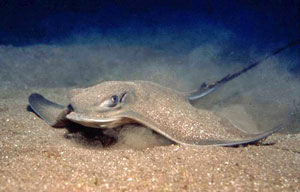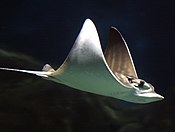
Manta rays are large rays belonging to the genus Mobula. The larger species, M. birostris, reaches 7 m (23 ft) in width, while the smaller, M. alfredi, reaches 5.5 m (18 ft). Both have triangular pectoral fins, horn-shaped cephalic fins and large, forward-facing mouths. They are classified among the Myliobatiformes and are placed in the family Myliobatidae. They have the largest brains and brain to body ratio of all fish, and can pass the mirror test.

Myliobatiformes is one of the four orders of batoids, cartilaginous fishes related to sharks. They were formerly included in the order Rajiformes, but more recent phylogenetic studies have shown the myliobatiforms to be a monophyletic group, and its more derived members evolved their highly flattened shapes independently of the skates.

Myliobatis is a genus of eagle rays in the family Myliobatidae.

Dasyatis is a genus of stingray in the family Dasyatidae that is native to the Atlantic, including the Mediterranean. In a 2016 taxonomic revision, many of the species formerly assigned to Dasyatis were reassigned to other genera.

Aetomylaeus bovinus, also known as the bull ray, duckbill ray, or duckbill eagle ray, is a species of large stingray of the family Myliobatidae found around the coasts of Europe and Africa.

Himantura is a genus of stingray in the family Dasyatidae that is native to the Indo-Pacific. In a 2016 taxonomic revision, many of the species formerly assigned to Himantura were reassigned to other genera.

The spotted eagle ray is a cartilaginous fish of the eagle ray family, Aetobatidae. As traditionally recognized, it is found globally in tropical regions, including the Atlantic, Pacific and Indian Oceans. Recent authorities have restricted it to the Atlantic with other populations recognized as the ocellated eagle ray and Pacific white-spotted eagle ray. Spotted eagle rays are most commonly seen alone, but occasionally swim in groups. They are ovoviviparous, the female retaining the eggs then releasing the young as miniature versions of the parent.

Aetobatus is a genus of eagle rays native to the Atlantic, Pacific and Indian Oceans. It was formerly placed in Myliobatidae, but is now placed in its own family Aetobatidae based on salient differences from myliobatids, especially the pectoral fins joining the head at the level of the eyes.

Aetomylaeus is a genus of eagle rays in the family Myliobatidae.

The purple eagle ray is a species of fish in the family Myliobatidae. It was formerly considered endemic to Australia but is now known to be more widespread. Its natural habitat is the open seas where it has a patchy distribution, and the International Union for Conservation of Nature has assessed its conservation status as being "near-threatened".

Urogymnus is a genus of stingrays in the family Dasyatidae from marine, brackish and freshwater habitats in the Indo-Pacific and tropical East Atlantic regions. The genus was previously considered to be monotypic, containing only the porcupine ray. Molecular phylogenetic research published in 2016 reassigned several species from Himantura to Urogymnus.

The whiptail stingrays are a family, the Dasyatidae, of rays in the order Myliobatiformes. They are found worldwide in tropical to temperate marine waters, and a number of species have also penetrated into fresh water in Africa, Asia, and Australia. Members of this family have flattened pectoral fin discs that range from oval to diamond-like in shape. Their common name comes from their whip-like tails, which are much longer than the disc and lack dorsal and caudal fins. All whiptail stingrays, except the porcupine ray, have one or more venomous stings near the base of the tail, which is used in defense. In order to sting their victims, they jerk their tails as the stinger falls off and stays in the wound that they have created. The stinger of a whiptail stingray is pointy, sharp with jagged edges. They range in size from 0.18 to 2.0 m or more across in the case of the smalleye stingray and giant freshwater stingray.

Taeniura is a genus of stingrays in the family Dasyatidae. The species Taeniurops grabata and T. meyeni were formerly placed in this genus. However, phylogenetic research has shown that these two species are not closely related to T. lymma, and they have been assigned to a separate genus, Taeniurops.

Batoidea is a superorder of cartilaginous fishes, commonly known as rays. They and their close relatives, the sharks, comprise the subclass Elasmobranchii. Rays are the largest group of cartilaginous fishes, with well over 600 species in 26 families. Rays are distinguished by their flattened bodies, enlarged pectoral fins that are fused to the head, and gill slits that are placed on their ventral surfaces.

Aetobatus narutobiei, the Naru eagle ray, is a species of cartilaginous fish of the eagle ray family, Myliobatidae. It is found in the northwest Pacific off south Japan, South Korea, China, Hong Kong and Vietnam. It occurs from shallow, coastal flats to a depth of 59 m (194 ft), but always in water warmer than 15 °C (59 °F).

The ocellated eagle ray or the whitespotted eagle ray, Aetobatus ocellatus, is a species of cartilaginous fish in the eagle ray family Myliobatidae. It is found in the tropical Indo-West Pacific region. In the past it was included in the spotted eagle ray, a species restricted to the Atlantic after the split.

The common eagle ray or bullray is a species of fish in the family Myliobatidae. It inhabits the eastern Atlantic Ocean, the Mediterranean Sea and the south-western Indian Ocean.

Hemitrygon is a genus of stingrays in the family Dasyatidae from marine, brackish and freshwater habitats in the central Indo-Pacific and northwest Pacific regions. The genus was formerly regarded as a junior synonym of the genus Dasyatis.

Telatrygon is a genus of stingrays in the family Dasyatidae from the central Indo-Pacific. Its species were formerly contained within the genus Dasyatis.

Aetobatus laticeps, the Pacific white-spotted eagle ray, is a species of cartilaginous fish in the eagle ray family Myliobatidae. It is found in the tropical East Pacific Ocean, ranging from Baja California to northern Peru, including the Galápagos. There has been recent evidence to suggest A.laticeps is in the Mexican tropical Pacific, more specifically in Chacahua Lagoon. However this evidence is insufficient and so the research being done on the spotted eagle rays in Chacahua Lagoon is working under the name A. narinari. Until 2014, it was included in the similar spotted eagle ray, but the two differ in genetics. Studies have been conducted to attempt to identify spot patterns at the individual level. A. laticeps and A. narinari both have white spots on the dorsal side of their dark body, making them difficult to differentiate. Following the split, A. narinari is restricted to the Atlantic, while the Indo-Pacific is inhabited by the closely related A. ocellatus.






















